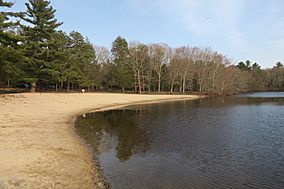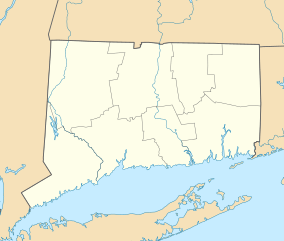Hopeville Pond State Park facts for kids
Quick facts for kids Hopeville Pond State Park |
|
|---|---|

Beach
|
|
| Location | Griswold, New London, Connecticut, United States |
| Area | 554 acres (224 ha) |
| Elevation | 213 ft (65 m) |
| Established | 1938 |
| Governing body | Connecticut Department of Energy and Environmental Protection |
| Website | Hopeville Pond State Park |
Hopeville Pond State Park is a fun outdoor area in Griswold, Connecticut. It's located right on Hopeville Pond, which is a large pond created from the Pachaug River. This park is huge, covering about 554 acres! A part of the park is actually where an old village called Hopeville used to be. The park manager even lives in a really old house called Avery House, which is a historic landmark. At the park, you can go fishing, swimming, camping, and explore trails for hiking and biking. The Connecticut Department of Energy and Environmental Protection takes care of the park.
Contents
A Look Back in Time
The Mohegan People and Early Fishing
Long, long ago, before European settlers came, the Mohegan people lived in this area. They were very clever at catching fish from the Pachaug River. They built special stone walls called weirs in the river. These weirs helped guide the water and fish to the middle of the stream. This made it super easy for them to catch fish in their baskets!
The Village of Hopeville
In 1711, a man named Stephen Gates got some land here. He built a gristmill (for grinding grain) and a sawmill (for cutting wood). These mills used the power of the river. Later, in 1818, Elizah Abel added a woolen mill to the site.
Then, John Slater bought all three mills. He built a new mill that made a type of fabric called satinet. He named his new mill the "Hope Mill." This is where the names for the village, the pond, and the state park all came from!
By 1840, Hopeville was a busy and successful village. People even built a church there in 1852. The village was best known for making wool products. Sadly, in 1881, the main mill burned down and was not rebuilt. Later, in 1900, the church and four houses also burned. In 1908, the original gristmill from 1711 was also destroyed by fire.
Around 1917, a company built a dam on the site. This dam created the 145-acre reservoir we now know as Hopeville Pond. The dam helped create electricity for their other mills nearby.
The Avery House
The Avery House, also known as Hopeville Pond Park House, is a very old house. It was built around 1770. It's a two-story house with a large chimney in the middle. It even has a root cellar built into its stone base.
In the 1930s, a group called the Civilian Conservation Corps (CCC) helped fix up the house for the park. They made some changes, like removing the kitchen fireplace. But many of its original door frames and iron latches are still there! After it was fixed up, the Avery House became the home for the Hopeville Park manager. It was listed as a historic place in 1986.
How the Park Started
The Civilian Conservation Corps (CCC) helped create Hopeville Pond State Park in the 1930s. This group of young men worked on many projects across the country. They were camped in the nearby Pachaug State Forest. Their hard work included getting the Avery House ready for park use. Hopeville Pond officially became a state park in 1938.
Fun Things to Do
Hopeville Pond State Park offers many exciting activities for visitors. You can go biking, hiking, and camping. It's also a great spot for fishing and boating on the pond. And when it's warm, you can go swimming!
The park has a campground with 80 campsites, perfect for a family adventure. Hopeville Pond is a popular place for fishing. You can find many different kinds of fish here. Some of the fish caught in the 137-acre pond include channel catfish, northern pike, largemouth bass, chain pickerel, yellow perch, smallmouth bass, and bluegill. People even enjoy ice fishing here in the winter!
The park also has an 11-mile bike trail that's great for casual cyclists. Hopeville Pond State Park is known as a wonderful place for tent camping in New England.


